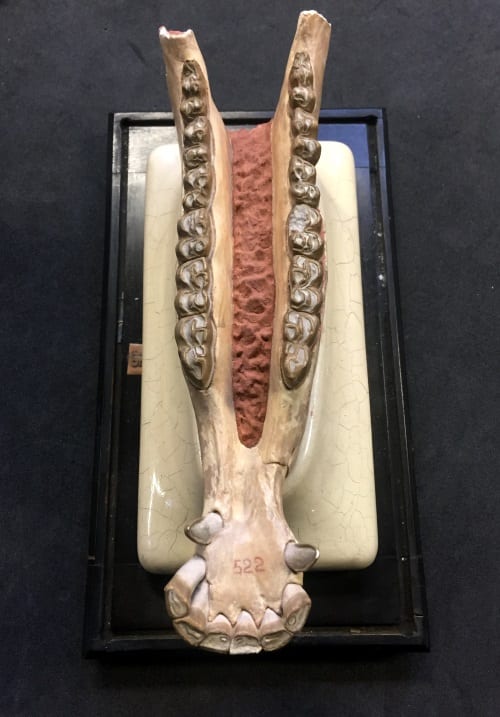Specimen of the Week 327: The Fancy Casts
By Tannis Davidson, on 26 January 2018
It’s that time of year when a very lucky specimen gets the research equivalent of the red-carpet treatment. Each January, students in UCL’s Collection Curatorship class (as part of their MA in Museum Studies) choose objects from across UCL’s collections to research in a practical project to introduce them to the core skills of a curator: to understand objects and how to research them.
Last year’s natural history group successfully cracked the mystery of the wax models and were able to not only identify them in their own right (as a developmental series of the freshwater leech Hemiclepsis marginata) but also revealed their place in the history of embryology as a rare surviving series made to illustrate Charles Otis Whitman’s 19th century pioneering work on cell lineage.
This year, the specimens chosen from the Grant Museum are a set of four beautifully-made painted plaster and ceramic casts which are unique in the Museum…
**The Fancy Casts**

The Fancy Casts (from top left clockwise) : LDUCZ-Z3259 Machairodus cultridens, LDUCZ-Z3243 Hipparion mediterraneum, LDUCZ-Z3258 Hipparion mediterraneum andLDUCZ-Z2733 Hipparion brachypus
Collectively known as the ‘fancy casts’, these four specimens are not your average reproductions. Exquisitely modelled, hand-painted and set in crackle-glazed ceramic bases, these casts are also mounted on painted black wood boards with glass lids (possibly later additions).
They are all of extinct species – presently identified as Machairodus cultridens (cast of partial skull and mandible), Hipparion mediterraneum (cast of mandible and cast of one side of palate) and Hipparion brachypus (cast of pes and portion of tibia). These identifications are based on the historic paper labels attached to the wood bases which appear to be earlier taxonomies which (depending on your source) may or may not be presently valid.
And so the first stage of identification begins…what species are these? I had a hunch that these could be casts of fossil remains excavated at Pikermi in Greece – the location of a palaeontological site which has yielded numerous mammal species from the late Miocene (8 million years ago) – many of which are type specimens. The species of our casts match those found at Pikermi, and the painted orange matrix detailed on the casts perhaps references the distinctive-coloured groundmass at the site.
Could these casts be reproductions of type specimens found at the site? If so, where are the original fossils? To answer this question, the students are going to have to delve into the history of Pikermi to find original descriptions of finds and hopefully be able to match up figured fossils with the Grant Museum casts.
We’ve had some great help here already from french palaeontologist Eric Buffetaut from the French National Centre for Scientific Research who identified the original Machairodus cultridens specimen figured in Roth and Wagner’s 1854 ‘Die fossilen Knochenüberreste von Pikermi in Griechenland. Abhandlungen der Bayerischen Akademie der Wissenschaften , 7: 371–464‘ . M. Buffetaut also spotted the original fossil on display at the Bayerische Staatssammlung für Paläontologie und historische Geologie in Munich. It is from Pikermi.
Were the casts possibly made in Germany? Was the original material studied elsewhere? Who else was at Pikermi? What about the other three casts? But identifying the original material is only part of the research aim. As manufactured specimens, there is another line of inquiry to pursue: who made these, where were they made, when were they made, why were they made? In the Grant Museum, the casts are actively used in teaching and like all of our specimens, that has always been their purpose. Were these casts mass-produced to be used in university teaching or were they meant to be primarily display specimens for museums? When did they come to the Grant Museum?
The students will be researching the fancy casts over the next several weeks and we’ll update you on their progress and results. In the spirit of collaborative research, if you have any information which could help this investigation, please get in touch.
**The results are in! Find out what the students found out about the fancy casts here.
Tannis Davidson is the Curator at the Grant Museum of Zoology
One Response to “Specimen of the Week 327: The Fancy Casts”
- 1
 Close
Close




Dear T. Davidson,
The cast of machairodont is described and figured by Roth and Wagner (1854: tab. IX) as Machaerodus leoninus. Today is known as Amphimachairodus giganteus. The reference is:
Roth, J. & Wagner, A. (1854). Die fossilen Knochenüberreste
von Pikermi in Griechenland. Abhandlungen
Bayerische Akademie Wissenschaften, München
Math.-Phys. Kl., 7: 371-464.
Difficult to say something for the hipparion remains as the known material is numerous dispersed in various museums and institutes.
Best regards
Prof. G. D. Koufos